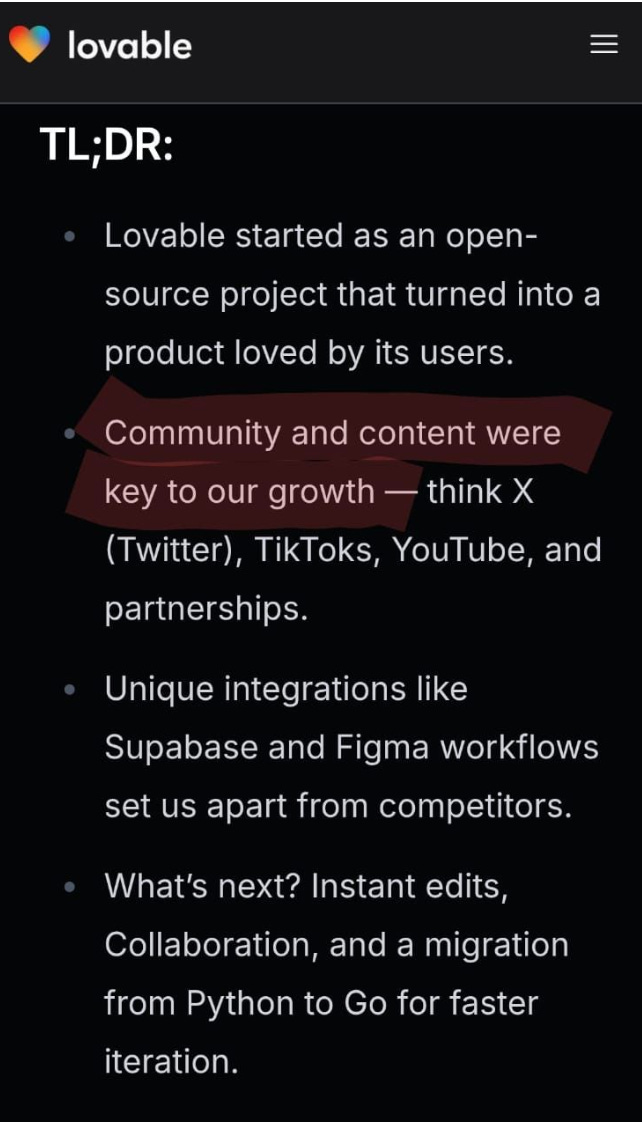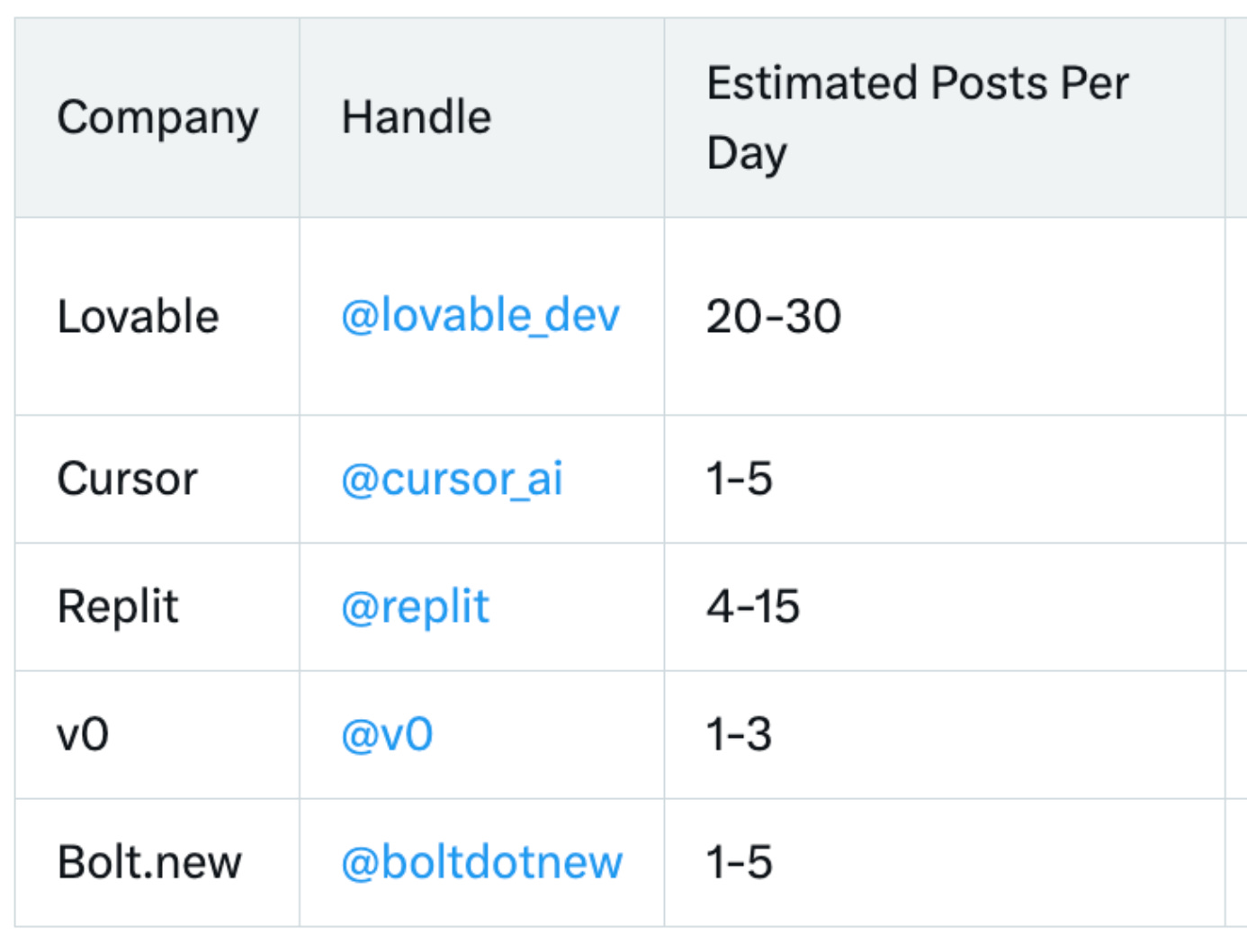From Zero to $30M ARR in 120 Days: How Lovable Crushed It Using Content
"We had built the best product on the market, yet this new competitor managed to overtake our ARR in just a few days. Within weeks, they had 40x'd our revenue. Everyone was talking about Bolt, while Lovable remained relatively unknown." - Isaak Fabien Sundeman Growth Marketing Lead; joined Lovable in Dec 2024
This wasn't just any startup's nightmare. This was Lovable in November 2024.
The Swedish AI coding platform (formerly GPTEngineer) had everything going for it: 50,000+ GitHub stars, a buzzing Discord community, and an AI product that turned coding into conversation. Their open-source project was a hit. Users loved the product.
But love doesn't pay the bills.
After two failed commercial launches (April and October 2024), Lovable watched helplessly as competitor Bolt rocketed to $4M ARR in just 4 weeks. The team was stuck in what CEO Anton Osika calls "monetization hell."
Then, something clicked.
By April 2025, Lovable had:
Hit $10M ARR in just 60 days
Reached $17M ARR in 90 days
Exploded to $30M ARR in 120 days
Burned only $2M to get there
Built a lean team of just 18 people ($1M+ ARR per employee!)
How did they pull off perhaps the fastest growth trajectory of any European startup ever?
One word: Content.
Think I am exaggerating? Check this screengrab from Lovable’s blog.
Even with product-market fit and a passionate community, Lovable remained invisible until they cracked the content code. What followed was nothing short of extraordinary.
I spent weeks dissecting Lovable's meteoric rise – analyzing their blog, tracking 100+ social posts, and studying founder interviews.
What follows is a breakdown of Lovable's content tactics. It's a masterclass in content-led growth that any AI company can replicate. Let’s go!
Seed Your Content
1. Show, don’t tell. Educate, don’t sell
Lovable's first move wasn't to advertise—it was to flood the internet with genuinely helpful content that made their users successful.
Created detailed tutorials to show product capabilities:
Published written content on concepts that align with their positioning:
Amplified case studies featuring real-world success stories on their blog:
Key takeaway: Show, don’t tell! Instead of telling people what your product does, show them exactly how to use it through real builds, case studies, and thought leadership. And don’t use it as a hook to sell to your users. Let them discover your product through your educational content.
2. Build in Public
Lovable made their journey public, turning their building process into a content stream that users could follow and engage with.
Founders became the face of the product
Anton Osika and Fabian Hedin personally responded to user queries in Discord
They spent hours in channels troubleshooting and discussing ideas with users
Every major Twitter mention got a personal reply from the founders
Ditched corporate-speak on social
Anton posted awkward selfies on LinkedIn and raw behind-the-scenes threads on X. He treated LinkedIn like Twitter—raw, authentic, and personal
This casual, founder-led approach cut through the noise of polished corporate accounts
Live 'Office Hours' with Founders
Instead of traditional marketing, Lovable ran weekly live sessions where users could:
See Lovable in action as founders built apps from scratch.
Get direct feedback on their projects.
Request feature demos in real time.
These office hours were later turned into blog content and used as case studies.
Key takeaway: Founders need to lead from the front and be accessible to early users across channels.
3. Launch, Tweak, Launch
Their Product Hunt launch was failing miserably—until Anton made three critical mid-day tweaks:
Ditched the waitlist - While they started with a waitlist as they were worried that too many new users will fry their servers, they remove it post noon to let users immediately access the product instead of joining a queue
This was crucial: users could try Lovable, have a "wow" moment, then return to upvote
Expanded beyond Product Hunt - Posted simultaneously on Hacker News to multiply reach
Repurposed the launch post and posted on Twitter, which recieved 20x better engagement
The results: 500K+ impressions, 16K signups, 850 paying users (5% conversion), and a perfect 5.0/5.0 rating with 75+ reviews on Product Hunt.
Key takeaway: Be willing to change tactics mid-launch and remove friction that prevents users from experiencing your product.
Create Social Proof Through User-Generated Content
After seeding the internet with their own content, Lovable implemented a genius strategy: let users create content for them.
1. Amplify User Wins Like There’s No Tomorrow
Treated every user build as a marketing opportunity to create social proof that this shiny new AI toy works.
70-80% of their posts on X are estimated to be reposts or quote posts of user projects. Some examples:
Livestreams with users: Launching a full-fledged SaaS without hiring developers. https://x.com/i/broadcasts/1MnxnworBLyKO
Demo builds: Someone built this weather app with Lovable by just prompting https://x.com/lovable_dev/status/1874534159756251195
Live coding/vibe coding with users https://x.com/Jacobsklug/status/1901992271941083338
Featured community members by name in blog updates & product launches
This created a sense of recognition, strengthening engagement.
Established a “Builder Hall of Fame” on the website
This showcased the most impressive projects as permanent case studies.
Created in-depth content around top-performing builds
Turned successful user projects into blog posts, tutorials, and video guides.
Key takeaway: Your best marketing comes from your users—amplify their success loudly and frequently.
2. Gamify Creation with Contests
Ran interactive social media contests on X (Twitter) to drive engagement.
Example: March 14, 2025, Contest
Challenge: Users had to quote a tweet showcasing their best website design made in Lovable.
Prize: $3,000 cash for the best entry.
Results:
992,087 views
1,091 favorites
A flood of user-generated projects showcased on X.
Not sure if this worked as per their expectations though because they didn’t run another contest after this.
3. Build Tools That Create User-Generated Content
They built “Launched”, a Product Hunt-style showcase platform, using Lovable itself. Devs/builders can submit projects on the platform, get showcased, and become widely visible. They created many loops on the platform to get more devs to share projects:
Created a weekly contest where the top 5 projects won 100 free Lovable credits
Added "Edit with Lovable" buttons on featured projects so a new user can pick it up and create something new. This way, any showcased app became a template that others could copy and build upon.
Addressed the "What should I build?" problem with pre-made examples
Thus, every successful user project on Launched became a marketing asset for Lovable.
Key takeaway: If you want more user-generated content, make it stupidly easy for people to share and remix projects.
Always go where your users are
1. Flood X with Content (Like, Obsessively)
Lovable is way more aggressive on X than other AI dev tool brands, posting 20 to 30 times a day. They realized that their most valuable users are on X, those who are tinkering around with other tools.
2. Break Platform Rules When Needed
Lovable's growth lead, Isaak, broke conventional platform rules by focusing on unexpected channels:
Bet big on TikTok when competitors ignored it
One viral TikTok video hit 1.1 million views
Nearly doubled their ARR in just 8 days
Created momentum for their third product launch
Made bold timing decisions
Scheduled product launch just 9 days after viral TikTok
Decided to completely rebrand from GPT-engineer to Lovable only 2 days before launch
Copied competitor tactics shamelessly
Manually reached out to hundreds of influencers
Discovered Bolt had done the same (and paid many)
Implemented similar approach but with their own authentic twist
3. Leverage Other Brands' Audiences
Partnered with complementary tools in the developer ecosystem which were already being used by their potential users.
Supabase for database functionality
Vercel for deployment
GitHub for version control
Created co-marketing opportunities with these partners:
Joint webinars demonstrating integrated workflows
Cross-promotion in newsletters and social media
Co-authored technical content
Key takeaway: Partnerships can expand your reach to established audiences without additional marketing spend
4. Turn Influencers Into Product Experts
Lovable aggressively pursued influencer partnerships, but they didn’t force the influencers to advertise at all costs.
Targeted the same influencers as Bolt - Primarily on YouTube, but also TikTok
YouTube presence was crucial. If a product doesn't have tutorials, it affects conversion and retention massively. People don't want to feel alone in learning new software.
Deep influencer onboarding
Sent comprehensive 1-hour tutorials covering all product features
Added influencers to Slack for direct access to the team
Made them true product experts who could genuinely educate their audiences
Zero creative restrictions
No scripted segments or forced messaging
Gave influencers full freedom to create authentic videos
Focused on audience value first, with Lovable featured naturally
Lean spending with big returns
As of February 2025, spent only $20K on influencer marketing
Were highly selective about partnerships, focusing on quality over quantity
Would have spent more if they'd found more suitable influencers
Total marketing costs (including ads) didn't exceed $40K
Key takeaway: Find influencers with perfect audience overlap, make them product experts, then let them create content their way—no forced sponsorship language or awkward promotions.
If you found this useful, consider joining the mailing list below.
Rohit



